A Symphony of Colour
Acclaimed British artist, Christopher Le Brun, returns to Berlin with a solo presentation filling Arndt Art Agency’s spaces with a symphony of colour. The title, “Now Turn the Page”, references the artist’s childhood experience with “talking books”. This conscious act of looking and listening continues to resonate with the artist and is the point of departure for his new body of work. Le Brun’s interest in multi-sensory engagement, paired with an enthusiasm for collaboration was the catalyst for this show. Pianist Annie Yim of MusicArt London was invited to hold a live discussion and piano recital upon the occasion of the opening. This unique concert gave each artist the opportunity to present their perspectives about artistic thought processes and musical structures by some of the great composers such as Scriabin, Schoenberg, Rachmaninov and Debussy.
In this exclusive A3 Editorial interview, Le Brun discusses the pursuit of authenticity through his work, the fundamental elements of painting and his strong connections to Berlin and the European tradition of painting.
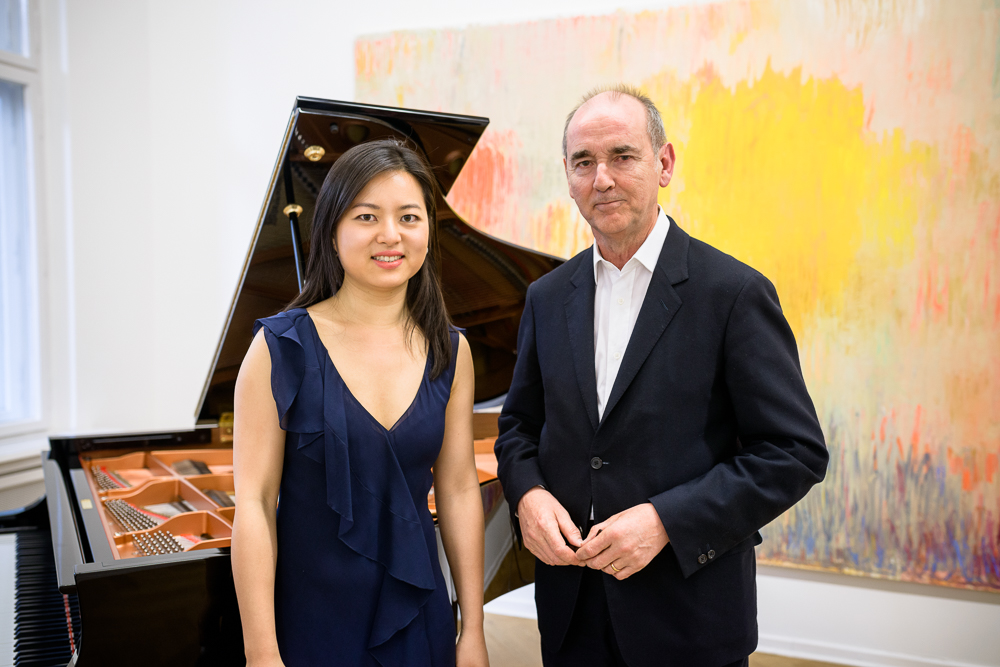
Pianist Annie Yim and Christopher Le Brun
You are collaborating with the pianist Annie Yim for your exhibition opening. This brings me to the question about your interest in working with other people from other disciplines. Has this always been something you are fascinated with?
It is. I realised I enjoyed it when I first started printmaking, because the life of the painter is so solitary. But whether it is with a bronze foundry or an etching studio, you are working with highly skilled technicians. So I enjoy the collaborations. They help me to bring out my own ideas more fully.
So in these conversations that you have, you start to make discoveries?
There are so many possibilities that working with a particular medium like bronze or print, that the possibilities start to narrow down. And when you work with a specialist, they narrow down again. That may sound contradictory, but it’s the concentration that’s rewarding.
Christopher Le Brun, Matthias Arndt and Annie Yim
You have parameters.
Exactly. The limits give guidance.
That’s talking about technical ideas. But working with someone who is a musician, a pianist, how does that translate?
In a way it’s similar, because Annie is introducing me to elements of music that I have thought about for many years, enabling me to see new things which I had perhaps assumed or taken for granted. But she has actually been able to demonstrate their significance. She has proved to me the underlying sense of what I have been thinking about.
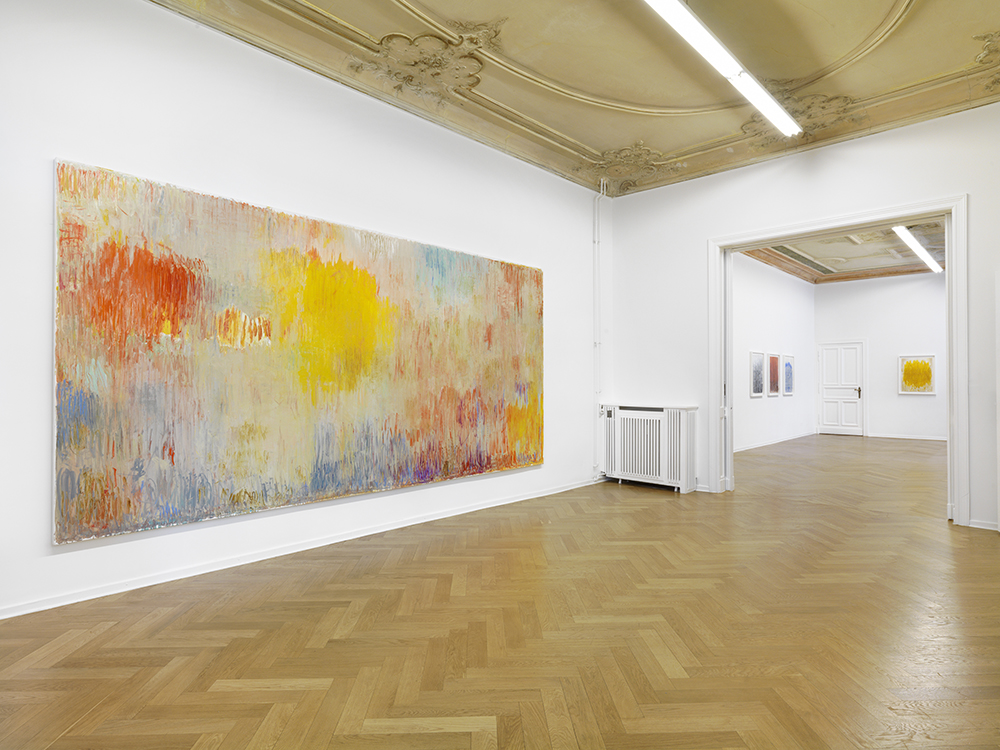
Installation view: Now Turn the Page, Arndt Art Agency, Berlin 2017
And in turn it works the other way, that she perhaps also sees a watercolour in a different way, or looks at your brush strokes and compositions in a new light.
She noticed a very simple thing when she was in the studio. She saw that most of the paintings have these vertical marks, a sort of raining light or note motif, but then occasionally a horizontal motif appears, which I think of as a wave motif, like light striking on waves and always appears to imply distance. Whereas the standing motif is here and present like a figure, like something coming closer. So these two simplest of forms already between them suggest a vast range of space.
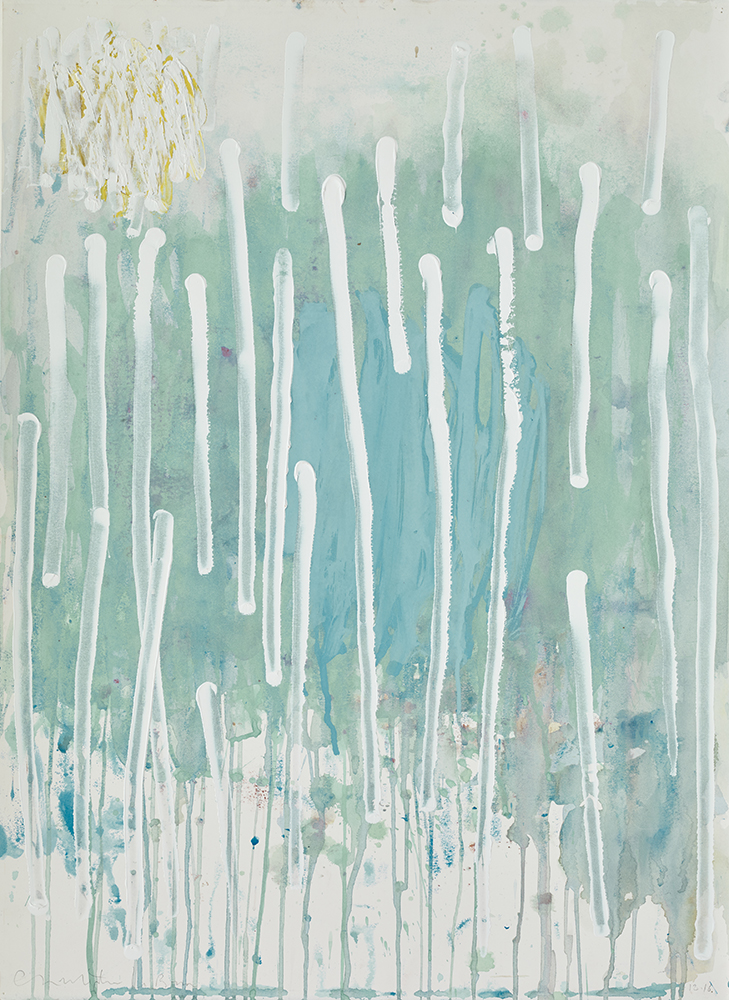
Christopher Le Brun, “Colour Study 25” (2017), watercolour and acrylic on paper, 76 × 50 cm
The vertical motif feels a bit more urgent somehow.
Yes, even in the action of the arm to make the vertical strike is like a chopping action or a hammer blow, but to make the horizontal mark is like a waving or smoothing, or even soothing motion, so they do have a different psychological feel.
Regarding this new body of work shown at Arndt Art Agency, it feels like the show is anchored around this amazing almost 4.5 metre wide painting “The Herald’s Note”. Was this work a central point for you in building the show?
Well I think the two key works are “The Herald’s Note” but also “Now Turn The Page”. They demonstrate two sides of what I do. So you could look at the “The Herald’s Note” almost like an encyclopaedic account of painting, what’s possible in shape, colour, texture, layering, covering, scale, line, activity and rhythm. So all of that’s in this painting. And you can also look at the works on paper, as it were, like the children of that big painting, like fragments of a totality. They are fragments that are complete in themselves but nevertheless they are events or passages that stand on their own from the big painting. So you can see that relationship.
And when you turn to “Now Turn the Page” that has apparently a very simple structure, because it is made of covering, so you see something almost like a list of one colour, of variations of one colour, that is pushed away from you with layers of off-white. Covering has come to have a great significance in my work, like an essential insight that once I discovered it has never been forgotten. That creates a very different atmosphere where you find yourself looking as it were through the surface into the painting in a searching or guessing way. Whereas in “The Heralds Note”, you barely need to search, you are organising the experience which is presented in abundance.

Installation view: Now Turn the Page, Arndt Art Agency, Berlin 2017
Organising is an interesting word to use, but you also used the word rhythm that is obviously very pertinent to this show. This sense of musicality it not uncommon in your work. Would you say the rhythm and passages is a type of story-telling for you, or it is more experiential?
It’s always experiential, it’s always about looking, it’s always about appearances, but the rhythm of the painting is the way in which I somehow find out whether it’s what I mean.
So it is very process driven.
It is very process driven. There are points in the process where the rhythm carries you with it and that carries me with it through what I call my physical imagination. Finding this place doesn’t come at all easily. Painting is a combination of pictures, pictorialising and painting. And painting is the physical, the direct side of painting. But I need to keep the two completely in balance. However, the one that is to some extent more reliable, is what I call the physical imagination. You could say it’s like asking yourself how you describe or tell the truth. Often a physical manifestation of who you are is more true than what you say.
Because you can’t argue with it.
You can’t argue with it, it’s how you are. And therefore the doing side of painting is a powerful test of authenticity.
And that’s something that is important to you?
Yes. I think one of the rare things about painting is that it depends entirely on touch. We are naturally interested in touch, we regard it as having a special component of regard and care and interest, rough, careful, tender, tentative; all these things. The piano has a wonderful response to touch, and painting likewise is the most perfect response and record of touch, it is so delicate, so tough and rhythmic.

Installation view: Now Turn the Page, Arndt Art Agency, Berlin 2017
And there is a visual residual.
There is visual evidence of feeling that remains. This isn’t conceptual, this is the physical reality of making painting. And that interests me very much – obviously. Because then the evidence of what you have done may become a picture and then the picture launches you into a different world of memory or implication.
Touching on the word memory, I read that your work “Now Turn The Page” references your childhood memories and experiences of talking books. This is an interesting point where two senses are merged: something you listen to and something that you see.
Yes exactly. This title just came into my mind one day quite soon after I had completed the picture and it just felt right. Because I had been thinking about music with the previous exhibition “Composer” and I remembered books that we had as children that came with long playing 78 rpm records. It involved listening, and looking, and touching, because you had to turn the page. And when you turned the page you revealed the next picture. The narrator told you the story and you would listen to the music. It was a very, very rich experience. The expression doesn’t mean turning over a new leaf in your life, it’s more to do with anticipation and experience.
So not a disconnection.
No. It is not saying “right I am starting again”. It’s more like – be aware. That’s the reference. And it also implies turning the page of a musical score; in other words you follow. In fact, when I recently found the books online I realised the narrator only says “Turn the page” but I remembered it as “Now turn the page” which puts you exactly in the present where you want to be.
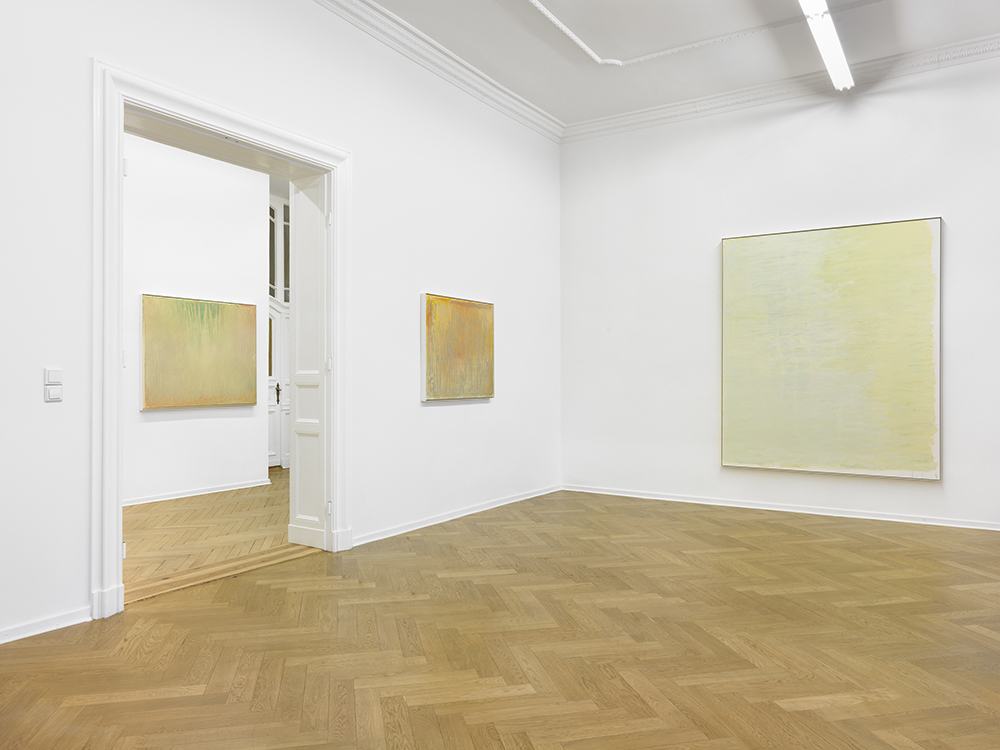
Installation view: Now Turn the Page, Arndt Art Agency, Berlin 2017
Considering your career’s trajectory it is interesting to note that you are coming back to Berlin for this show after having shown in Berlin several times over the years. I would like to end the interview by talking about your connection to Berlin.
We lived in Berlin as guests of the D.A.A.D between 1987 and 1988 before the wall came down. At that time Berlin was an island. We travelled in Poland, East Germany and Czechoslovakia. So it was an immensely valuable lesson in European history. Just as important was meeting my fellow German painters and getting a sense of the difference in status for a painter in Germany compared to my experience in England. I had the sense that, in the way the painters behaved and lived, I was seeing something of a former Europe. There was a role in society. Artists in England seemed more tangential, somehow disorganised.
In terms of recognition?
More of individual recognition. The British system, essentially to generalise, is time and again a tradition of single artists. We don’t form schools, it makes us uncomfortable. But actually what was impressive and important was that there was a type of momentum in German painting at that time in the early 80s. There was contributory discussion and dialogue, not of agreement, more like rivalry, but energetic, with conviction. Conviction about the importance of the medium and importance of art. So I learnt a lot from that. And that followed on from showing in this famous exhibition “Zeitgeist” at Martin-Gropius-Bau in 1982. That was very important for me in my career at that time. I remember on the night of the exhibition in the back room of the Paris Bar and artists and dealers were going from table to table making appointments and sorting out the next decade. And that’s what we did, six months later I went to New York and I was in the blissful position of virtually being able to select my gallery.
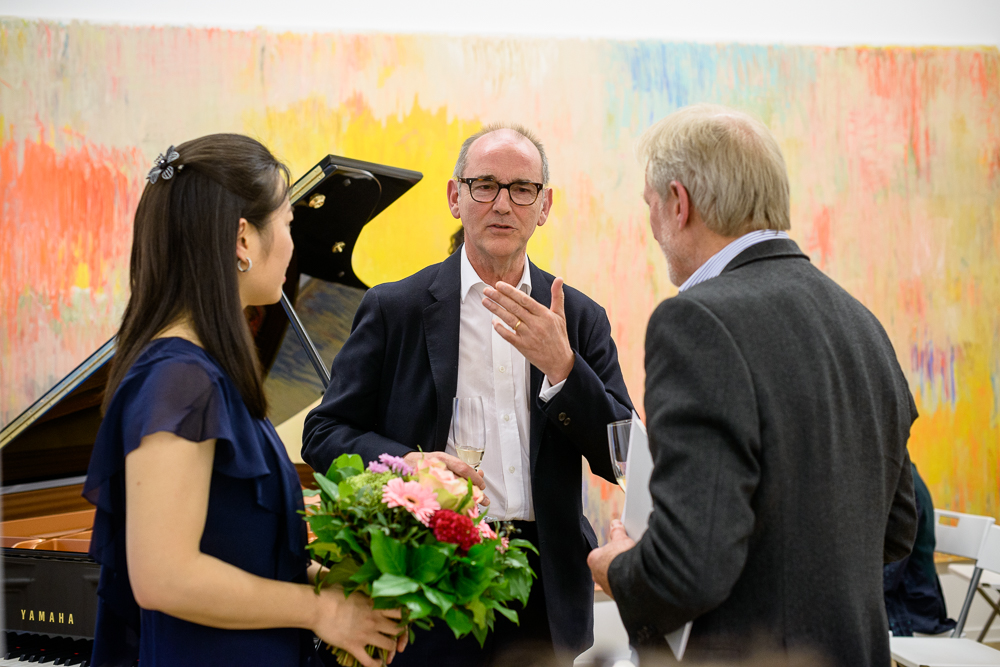
Annie Yim and Christopher Le Brun
How do you assess your artistic practice in light of these past experiences?
I am reminded when I come back to Berlin of how much my work is connected and embedded into European culture. Because you will notice in the concert program the inclusion of music by Schoenberg, Scriabin, Rachmaninoff, and Debussy. So that resonance and echo is very important to hear in my work, because that’s what gives colour and range to what I am doing in the present.
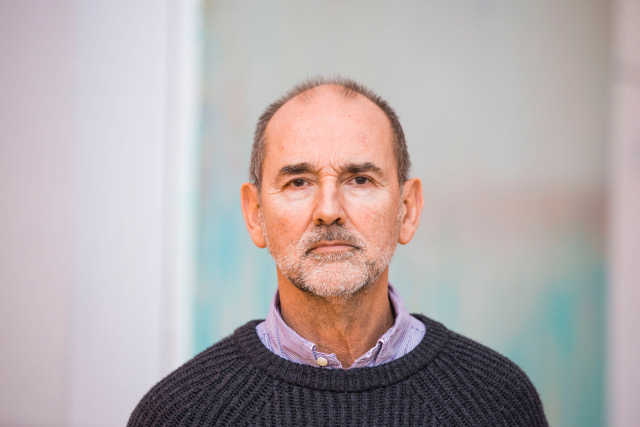
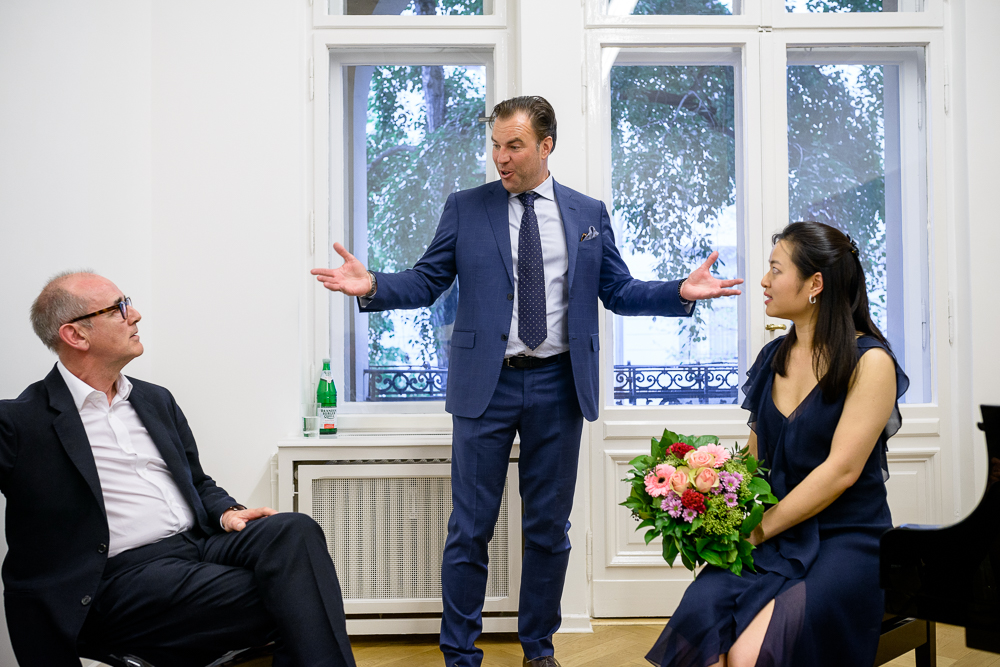
To whom it may concern,
this looks like a beautiful exhibition and one which I regret that I missed, as I live and work in London. Le Brun’s painting has a combination of the subtle and the bold shift of mark and tonality that I look for in my own. Inspirational.
LikeLiked by 1 person